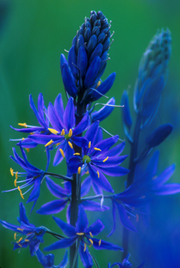| |
 Eastnor Horticultural Society Eastnor Horticultural Society 
Summer 2003 Newsletter
Message from the President
First, I must thanks the members of the Society for the kind expressions of sympathy that I received from you upon Frank's death. I was very touched by the flowers and many kind words. Everyone on the executive has been greatly affected by health concerns which has interfered with our ability to carry out our duties. Martin Hogarth has kindly assumed the duties of treasurer, and the container and other plantings group of members have most successfully carried on independently. Thank you all for your support and understanding in that respect.
Plant Sale
On Wednesday, July 30, on the grass strip behind Hellyer's Grocery Store, we have been permitted to hold a plant sale. This will replace the one that we normally have at Flower Fantasy. Please bring any eatra plants that you are willing to share, and any garden related items, eg: good pots, plant stands, etc., that you can also part with. Also, Mrs. Britton has donated her excellent collection of cacti. Ron Schenk and Elaine Hunter and I have been nursing some plants in the Barrow Bay greenhouse for this event. I hope many of you will support this effort.
Meeting
The next meeting will be September 24. (We traditionally take a break in August.) I am hoping for a topic of 'mushrooms'
Other Business
October is the last meeting of our financial year, the books close October 31, so remember to hand in any memberships or bills to Martin before then.
The Annual Meeting will be in November. As you can expect, we will be looking for a new executive for then.
Camassia quamash
(This plant was seen in a road side garden on West Road near Pike Bay this spring.)
Blue camas
Common camas
Liliaceae (Lily Family)
 Description
Description
Herbaceous perennial with large underground bulbs up to 1-1/2" thick and almost 2" long, covered by a membranous brown skin. The grass-like leaves are basal 3'4" wide and up to 15" long. The flower stems are up to 20" high bearing a loose terminal cluster of showy blue blossoms in late spring (sometimes odd white flowers occur).
Habitat
Meadows and grassy bluffs in soil pockets on rock outcrops, and prairies.
Use
Bulbs used for food. They were most often steamed. When cooked the bulbs taste sweet. The bulbs contain a complex sugar called inulin. Slow cooking (up to three days) promotes the conversion of inulin to its individualized
components of the sweet tasting and more digestible fructose. The concentration of fructose in cooked camas is as high as 33% of the wet weight or 43% of the dry weight. (Turner et al., 1980)
Blue camas is commonly called "black" camas because the bulbs turn black when pit-cooked.
After pit-cooking, the "black" camas (now soft, dark, and sweet) is either dried, ground and mixed with flour, water and a bit of butter to make a "gravy," or boiled before being eaten. Some tribes preferred to store the bulbs in the rafters of their homes. This was considered a better tasting bulb from those stored underground all winter. The larger "black" camas bulbs were reserved for elderly people; if young people ate them, it was believed that they would later marry an old person.
[Turner et al., 1980]
Contact for this page: Sandie Turner (TurnerS@wsdot.wa.gov)
|
|
 Eastnor Horticultural Society
Eastnor Horticultural Society 
 Description
Description